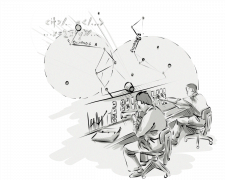In digital advertising, a demand-side platform (DSP) plays a big role, as it helps advertisers buy ad space from multiple publishers. Inside the DSP, there’s a part called the bidder, which automates the process of bidding on ads.
But here’s the thing: the DSP and the bidder are slightly different. The DSP encompasses a comprehensive system with various components and features and serves as the platform for advertisers to purchase and oversee digital advertisements, whereas the bidder’s role is bidding on ads according to the advertiser’s specified targeting parameters.
When it comes to using or offering a DSP, companies can either build one, rent one, or buy one. This decision is important from a strategic point of view, as it involves different costs and effects, but not every company has the same opportunity; i.e., for some companies, the only choice will be to build a DSP, whereas others might be better off renting or acquiring a DSP.
In this blog post, we’ll discuss the pros and cons of building a bidder or a DSP for advertisers, brands, and tech companies.
Key Takeaways
- A demand-side platform (DSP) is an advertising technology platform that allows advertisers to buy ad space from publishers in real-time, targeting specific audiences.
- DSPs emerged in 2007 with the introduction of real-time bidding, allowing advertisers to procure ad space from multiple publishers at once.
- The features of a DSP include ad campaign optimization tools, integrations with ad exchanges, supply-side platforms (SSPs) and data platforms, analytics and reporting modules, and a user-friendly interface.
- A bidder is a key component of a DSP. It uses algorithms to place bids on ad impressions based on the advertiser’s targeting criteria, ensuring the acquisition of valuable impressions at optimal cost.
- The key features and requirements of an RTB bidder include modularity, speed, reliability, scalability, and efficiency.
- Companies have three options when it comes to using a DSP: building one from scratch, renting an existing one, or buying and customizing an existing platform.
What Is a Demand-Side Platform (DSP)?
A demand-side platform (DSP) is an advertising technology (AdTech) platform where advertisers buy ad space on an impression-by-impression basis from publishers via ad exchanges and supply-side platforms (SSPs).
DSPs will integrate with dozens of different ad exchanges and SSPs to increase an advertiser’s chances of reaching their target audiences.
A DSP is like a stockbroker for ad space, where advertisers and agencies buy ad inventory from publishers just like investors buy stocks from companies.
The emergence of DSPs dates back to 2007, when real-time bidding first appeared, allowing advertisers to buy ad inventory on an impressions-by-impression basis across numerous publishers.
Despite being perceived as existing for the singular purpose of buying available ad space, DSPs include various components to manage, deliver, optimize, and report on ad campaigns.
These components include:
- Ad campaign optimization elements, such as budgeting, campaign tracker, and bidder.
- Integrations with ad exchanges, SSPs, and data platforms.
- Analytics and reporting modules that provide comprehensive data and analytics to advertisers and ad agencies, allowing them to optimize their RTB purchases based on insights from previous ad buys.
- User-friendly interface for properly creating, managing, and optimizing ad campaigns.
An essential feature of DSPs is their ability to leverage data from data management platforms and other sources to improve ad targeting and optimize media purchases. Through these insights, advertisers can run campaigns more effectively, reaching their target audience with increased precision.
What Is a Bidder?
A bidder is a key component of a DSP that is responsible for making real-time bidding decisions on behalf of advertisers. Essentially, it incorporates algorithms that place bids on ad impressions based on various parameters and targeting rules the advertiser sets.
When a user visits a website, an ad impression opportunity is created and sent to an ad exchange. The ad exchange then auctions off this ad impression to DSPs.
The bidders within DSPs evaluate the ad impression based on the advertiser’s predefined criteria, such as audience demographics, the user’s browsing history, and time of day. After evaluating the bid request, the bidder determines the value of the impression and places a bid accordingly.
This entire process, from the moment the user visits a website to the placement of the ad, happens in milliseconds, which is why it’s known as real-time bidding (RTB). The goal of the bidder is to win impressions that are most valuable to the advertiser while ensuring cost-effectiveness by bidding the optimal amount to win the ad space without overpaying.
Key Features and Technical Requirements of an RTB Bidder in a DSP
A bidder is a critical component of a real-time bidding (RTB) system in digital advertising.
Here are the key features of an RTB bidder:
- Modularity and customizable algorithms: A bidder supports various modules and adaptable bidding algorithms. These modules can ascertain factors like the publisher’s URL and the user’s location. Additionally, the bidding algorithms can adjust bidding behavior based on certain criteria, such as bidding higher for specific URL categories or pacing bids to avoid exhausting the entire budget at the campaign’s onset.
- Speed and reliability: Given that most ad exchanges mandate a bid response latency of less than 125 milliseconds, bidders are built to receive and respond to bid requests before being timed out. They are located in the same data center as the ad exchange in order to respond to the bid request in time. The architecture of these bidders is designed to be asynchronous so that they can maintain rapid response times even when interacting with third-party services. Bidders also need to maintain high performance.
- Scalability and efficiency: Bidders need to be scalable and operate efficiently to maximize the use of resources. A balance should be struck between optimizing the bidder for performance and using additional hardware resources. During peak Internet traffic periods, leveraging cloud computing enables server resources to be scaled appropriately.
Now, let’s look at the pros and cons of building your own RTB bidder or DSP.
Pros and Cons of Building a DSP or a Bidder for Tech Companies
Determining the optimal approach for integrating a DSP into your digital advertising strategy involves carefully considering various factors. For tech companies, the sole viable option is building a custom DSP. At the same time, brands, agencies, and other enterprises can choose between building, renting, or buying based on their business objectives.
Building a DSP from Scratch
Creating a DSP from the ground up is a daunting task, but it comes with several potential advantages. However, this approach is best suited to companies with existing tech (e.g., AdTech companies) or ad agencies with a substantial media budget that can secure the necessary technical expertise for the maintenance and development of the platform.
Advantages of Building a DSP
- No markup on media: Cut out the middleman and save on commissions.
- Intellectual property ownership: Building their own DSP adds to a company’s asset portfolio.
- Control over data: The company retains full ownership and control over their data, ensuring no third-party access.
- Control over DSP features: The agency has the flexibility to design and modify features based on their specific needs.
Disadvantages of Building a DSP
- High costs: Building a DSP from scratch involves significant upfront and ongoing expenses.
- Long development cycle: It takes time to develop a functional DSP and start running campaigns through it.
- Learning curves: Understanding the intricacies of a custom-built DSP can be challenging.
- Maintenance and infrastructure costs: These are recurring expenses that are unavoidable.
- Connection with SSPs and ad exchanges: Establishing relationships with supply-side platforms (SSPs) and ad exchanges is an additional challenge that requires resources and can be particularly daunting for inexperienced developers.
For tech companies, building a custom DSP is the only route available. The unique technical capabilities and innovative ethos of tech companies position them to take full advantage of developing a DSP tailored to their specific needs. While this endeavor necessitates significant investment and expertise, the rewards include complete control, data ownership, and the opportunity to refine the DSP’s features over time.
One of the major challenges in building a DSP is securing seats at the major ad exchanges. As a newcomer, you may lack the credibility or purchasing volume required to earn these seats initially. However, if you have existing relationships with supply-side platforms and ad exchanges, then it is a matter of handling the technical side of the integrations.
Alternatives to Building a Custom DSP
If building a DSP from scratch is not feasible, there are other alternatives that offer similar benefits.
One alternative is to build a meta-DSP.
A meta-DSP is a piece of software that sits on top of existing DSPs andhelps manage and automate campaign design, targeting, trafficking, and reporting across various DSPs.
In contrast to a standard DSP, a meta-DSP typically doesn’t engage in media buying itself. Instead, the DSPs linked to the meta-DSP handle media buying through RTB auctions.
The primary function of a meta-DSP is to provide brands and advertising agencies with the capability to create, configure, and oversee multiple campaigns across diverse DSPs using a single user interface.
A meta-DSP evaluates the distinct targeting capabilities and inventory sources of the connected DSPs. It can also select the most appropriate DSP for procuring a specific impression, guided by the campaign’s KPIs.
Summary
The choice between building, renting, or buying a DSP comes down to your company’s budget, technical capabilities, and specific business needs. Each option comes with its own set of pros and cons that need to be carefully considered before making a decision.
The post Pros and Cons of Building Your Own RTB Bidder or DSP appeared first on Clearcode.
The original post is at AdTech Archives – Clearcode




Leave a Reply